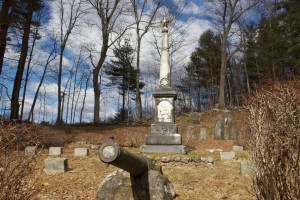By Walter W. Woodward for Connecticut Explored
Except for an occasional descendant in search of lost roots, visitors to the old Phoenixville Cemetery in Eastford these days are few and very far between. But 150 years ago, on September 5, 1861, thousands of men, women, and children ringed the hillside surrounding this small graveyard to witness the interment of native son Nathaniel Lyon. Lyon, whose pallbearers included the governors of Connecticut and Rhode Island along with two army generals, was at that moment the most celebrated figure in the United States. The preceding month—though then all but unknown—he had instantly become a national symbol for what lay in the country’s future—and of what that future might cost. For on August 10, 1861, at Wilson’s Creek, Missouri, Nathaniel Lyon became the first Union general to die in the Civil War.
His death came from a rifle shot through the chest as the mounted commander rallied Iowa troops against a much larger Confederate force. It was the kind of death the Connecticut-born Lyon would have wanted. A West Point graduate and soldiers’ soldier, he had received three promotions for gallantry during the Mexican War and was recently elevated to general for his actions protecting the federal arsenal at Saint Louis. Lyon’s military tactics are credited with keeping Missouri from joining the Southern cause.
First Union General to Die in Battle Receives a Hero’s Welcome
News of Lyon’s heroic death, coming in the wake of the Union’s shameful rout at Bull Run, gave the North a cause for honorable mourning. Plans were made to return Lyon’s body to Connecticut, and city after city along the way staged solemn commemorations. Saint Louis, draped in mourning, provided an “immense” military escort, according to an account in The Herald of Saint Louis. In Cincinnati, Lyon lay in state, protected by a military honor guard. At Pittsburgh and Philadelphia, hundreds of soldiers met the casket and accompanied it through town. In New York, Lyon again lay in state—in the Governor’s Room of City Hall—and was visited by more than 15,000 mourners.
In Hartford, though it rained “as if the gates of Heaven had broken loose,” according to The Last Political Writings of Gen. Nathaniel Lyon, a huge procession accompanied Lyon’s body from Union Station to the State House, where it lay overnight in the Senate Chamber. The next day a special train transported Lyon’s corpse to Willimantic, from which more than 300 wagons carried the funeral contingent 12 miles to Eastford. People young and old lined the roads as the three-mile-long wagon train inched toward Lyon’s birth town. Nearing Eastford after dark, they found the road lined with “myriads of lights, candles, lanterns, and rushes” to illuminate the path. Minute guns sounded, church bells tolled, and the procession played the “Dead March in Saul” as the body was placed in the Congregational church.
Twenty-thousand people attended Lyon’s outdoor funeral service the next day. Orators included the Speaker of the US House of Representatives Gerusha Grow of Pennsylvania and an Ashford native, governors Buckingham of Connecticut and Sprague of Rhode Island, and many other dignitaries, whose solemn and patriotic remembrances filled the day. Late that afternoon, the procession made its final journey to the Phoenixville cemetery. At 5 pm, as soldiers lined the graveside, thousands watched from the hills, cannon and musket fire filled the air, and the band played “Auld Lang Syne,” Nathaniel Lyon’s life journey ended.
“Nathaniel Lyon, though slain, will live forever in the memory of his countrymen,” Speaker Grow had proclaimed. “His body is interred in his native soil, his monument is the granite hills, and his headstone a nation’s grief.”
Walter W. Woodward is the Connecticut State Historian.
© Connecticut Explored. All rights reserved. This article originally appeared in Connecticut Explored (formerly Hog River Journal) Vol. 9/ No. 2, SPRING 2011.
Note: ConnecticutHistory.org does not edit content originally published on another platform and therefore does not update any instances of outdated content or language.










